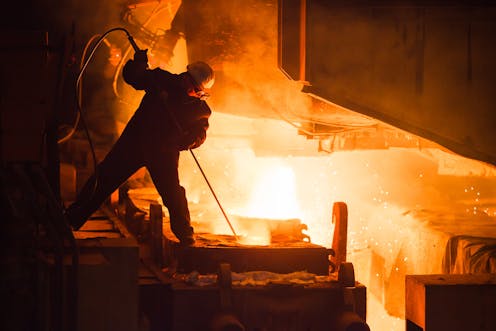Yes, it’s difficult for governments to pick green industry winners – but it’s essential Australia tries
- Written by Llewelyn Hughes, Professor of Public Policy, Crawford School of Public Policy, Australian National University

Since the 1990s, the economic agenda of governments across much of the world has been dominated by the Washington Consensus. This is a series of policy recommendations centred on privatisation of state businesses, deregulation of industries, liberalisation of trade, and opening economies to foreign direct investment.
As a result, industrial policies – where governments actively shaped the structure of economic activities towards a public purpose – fell into disuse in many parts of the world.
Now, after decades in the doldrums, industrial policy is back – with a green twist. The United States, European Union and Australia are spending hugely in a bid to respond to climate change, while trying to make domestic industries more competitive. There’s also a clear geopolitical aspect – Western nations are trying to reduce their reliance on China in the name of economic security.
Australia’s new industrial policy, Future Made in Australia is being debated in parliament. Amongst other things, it will use public funding to help homegrown industries benefit from the global low-carbon energy transition. The plan supports the creation of new industries such as green hydrogen and the expansion of existing ones, such as the manufacture of solar panel components and mining of critical minerals important to the green transition.
Returning to industry policy has not gone unquestioned. The Productivity Commission, an independent federal advisory body, recently argued we should be cautious about this approach to stimulating the economy because it’s hard for governments to identify where Australian companies and industries can compete – and failed public investment could make us less well off.
Green stimulus, as far as the eye can see
Australia did not move first. Green industrial policies are surging around the world. The International Monetary Fund has counted more than 2,500 worldwide as of 2023, largely in developed countries.
Across the Asia Pacific, governments never really gave up using industry policies. In particular, China’s government has supported its industry heavily and over a long period. This is one reason why China’s producers are now so dominant in green tech sectors such as solar photovoltaics.
What is genuinely new is how the US, Germany and other Western nations are embracing green industrial policies. The US Inflation Reduction Act announced by President Joe Biden in 2022 contained around A$560 billion in green stimulus, following the European Union’s 2020 Green Deal.
But can governments pick winners?
The Productivity Commission is worried the government will struggle to use subsidies and tax incentives to successfully support selected industries. Can we really pick winners? What if we fail?
These are important questions to answer. But we should remember we have been picking winners for decades in one sense, even during the era of untrammelled globalisation.
Australia has benefited from decades of international trade and investment in carbon-intensive bulk commodities such as coal and gas. But the picture of our true competitiveness is distorted by the lack of an effective carbon price. Would Australia have exported $65 billion of thermal coal last year if global policies fully accounted for the environmental damage done by burning coal?
Regardless, as our major trading partners go green, demand for these carbon-intensive products will fall. The key question is not if, but how fast?
In the absence of an international price on greenhouse gas emissions, green policies are necessarily going to be a patchwork of subsidies and other kinds of incentives.
So the question is not really whether to get into the industry policy game, but how to do it right.
Read more: Climate holdout Japan drove Australia's LNG boom. Could the partnership go green?
What do best practice policies look like?
Picking winners is hard. That doesn’t mean green industrial policies will fail.
We need to look at this as an information problem. Let’s say you want to identify how Australia could best compete and contribute to global value chains for emerging products, such as low-carbon steel or offshore wind turbines. Neither governments nor industry have all the information needed to make the best choices. That means collaboration is key.
The first and best response focuses on enabling governments, industries, and communities to better work together in identifying our strengths, and collaborate on an ongoing basis. It’s also useful to do detailed analysis of industrial processes and capabilities, as we did recently for the solar industry.
Research also indicates we are more likely to succeed in areas related to our existing strengths. But Australia is weakly diversified, meaning we have a lot riding on the success of a few industries such as iron ore, coal and gas.
This suggests there is real benefit to building new capabilities and industries by spending on research and innovation. The amount we spend on public research and development in the energy sector is low by international standards.
Importantly, this approach to industry policy relies on having governments with greater ability to do things rather than outsourcing. Reinvesting in government capacity to act is going to be essential.
But green industrial policy doesn’t mean retreating into protectionism. Throughout the transition to low-carbon energy, we will remain highly interdependent with our trading partners.
In low-carbon steel, for example, our ability to carve out a niche in emerging supply chains will rely in large part on collaborating with trade partners regionally and globally.
Try, fail, iterate, succeed
For many years now, scholars have forecast the retreat of globalisation. The new era of global competition centred on green industrial policies is unlikely to be reversed soon.
The Productivity Commission has contributed to the debate by noting that designing and implementing good policy is hard.
Caution is important. But so is seizing the moment, as governments and industry scramble to benefit from the transition to low carbon economies.
Authors: Llewelyn Hughes, Professor of Public Policy, Crawford School of Public Policy, Australian National University





